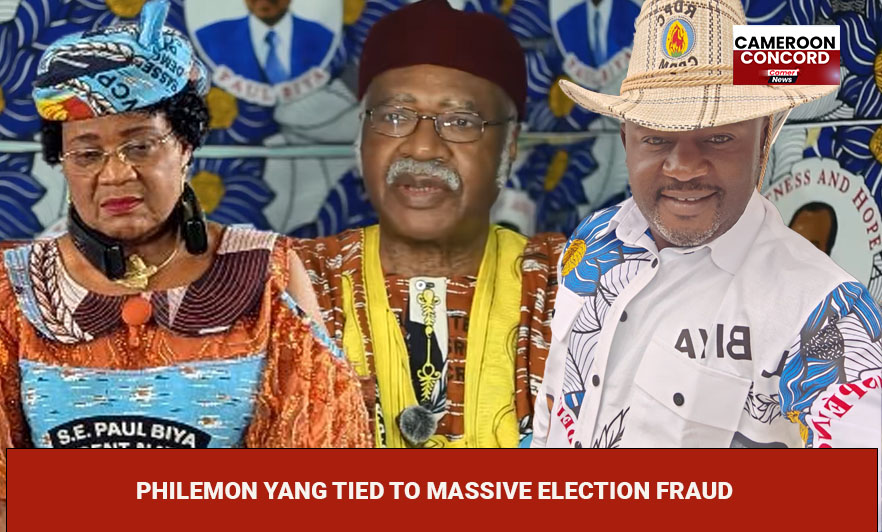- Details
- Politics
From Diplomat to Kingpin: Yang’s Election Fraud Network
YAOUNDÉ, Oct 18]– The Fragile Veneer of Legitimacy Cracks days after the October 12, 2025 presidential vote, Cameroon faces a legitimacy crisis more profound than ever. A damning revelation by Boris Betolt, a whistleblower inside the regime’s network, implicates Philemon Yang — formerly president of the UN General Assembly and ex-Prime Minister — as a central figure in the construction of a fraud machine targeting the North West Region.

Betolt claims that the rigging was not ad hoc, but systematically planned and coordinated before election day. According to his account, Yang oversaw the deployment of a multi-tier apparatus involving ELECAM’s regional substructures, local CPDM cells, and administrative officials. Their mission: to rewrite the will of voters in zones where turnout was expected to be weak or opposed to the ruling party.
The Anatomy of the Fraud Network
Betolt’s testimony — corroborated by leaked internal documents and interviews with insiders — offers granular detail on how the rigging unfolded:
Choice of Soft Targets
Regions like Momo, Bui, Donga-Mantung, Ngoketunjia and parts of the SW/Anglophone periphery were preselected as fraud zones because of low anticipated turnout, conflict displacement, and “ghost towns.” In many locales, residents avoided polling sites due to security fears or mandated ghost-town days.
Ballot Stuffing & Urn Manipulation
After polls closed, ELECAM agents and CPDM activists reportedly reopened urns and inserted hundreds or thousands of ballots, often in concealed sideline rooms. Videos circulated on social media show individuals bearing ELECAM vests filling envelopes with ballots and affixing fingerprints on registers.
PV Falsification & “Double Versioning”
Each polling station’s signed procès-verbal (PV) was replaced with a version amended upward in favor of Biya — sometimes dramatically. These fake PVs were then used to overwrite the “real” tallies in aggregation units. Betolt says many ELECAM department headquarters received only the falsified version, while original ones were suppressed.
Phantom Vote Absorption
In divisions like Momo, where many had fled or boycotted voting, Biya’s tallies soared to over 13,000 votes — a statistical anomaly. In Njinikom, CPDM insiders pushed official numbers from under 100 to over 2,500 votes. Whistleblowers like Maurice Tiibam Kube have publicly resigned and denounced such “mathematical miracles of fraud.”
Yang’s Role & Coordinated Oversight
According to Betolt, Yang was looped into all key fraud operations. He allegedly signed off on result templates, transmitted plans to provincial coordinators, and received summaries from department-level manipulators like Fai Yengo Francis, Fuh Calistus, Ngala Gerard, Njimgum Musa, Mbah Acha. The fraud program was structured with chain-of-command oversight.
Contextual and Historical Echoes
This scheme is part of a decades-long pattern. The Biya regime has long been accused of electoral manipulation — a practice known colloquially as “made in Cameroon” fraud.
Earlier editions of fraud included vote suppression, gerrymandering, and intimidation — but the 2025 playbook appears exponentially more audacious, leveraging digital leaks, live videos, and real-time citizen scrutiny.
Betolt’s account also dovetails with mounting evidence of irregularity: opponents were barred from running (e.g. Maurice Kamto was excluded)
; the regime placed restrictions on publishing results too early
; crowds have already been mobilized in cities like Douala, Bafoussam, Garoua, Dschang to demand access to PVs and truth.
Risks, Gaps & Verification
While Betolt’s revelations are compelling, they remain allegations until corroborated by open evidence. Some caveats:
Chain of custody gaps: proving which versions of PVs were “original” vs. “altered” may require forensic audit of sealed records.
Witness intimidation: many insiders may still refuse to speak publicly due to threats or regime coercion.
Absence of international observer access: no independent foreign observers had full access to aggregation and regional offices — so many internal claims are opaque.
Temporal pressure: Betolt’s testimony emerged just as tensions peak; regime reaction may include disinformation, media shutdowns, or arrests to suppress leaks.
Still, the scale and specificity of his claims — matched with viral videos showing ballot-stuffing in the NW — demand immediate judicial and civil society investigation.
What It Means for Cameroon
If Betolt’s allegations hold, they blow open the façade of legitimacy the Biya regime has long cultivated. A fraud network of this magnitude — involving a former UN diplomatic actor — signals a regime cornered, losing control not only of narrative but infrastructure.
For Issa Tchiroma Bakary, this confirmation could transform his self-declared victory into a widely accepted mandate. For civil society, the leak offers evidence to support legal challenges. For international actors and observers, it presents an inflection point: remain silent or demand consequence.
One thing is certain: the regime can no longer rely on its old tools. In 2025, transparency, cameras, and citizen oversight become the new checks — and they are already proving more potent than paper ballots.
- Details
- News Team
- Hits: 220
